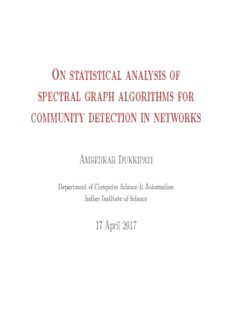
Ambedkar.Dukkipati.1.. PDF
Preview Ambedkar.Dukkipati.1..
On statistical analysis of spectral graph algorithms for community detection in networks Ambedkar Dukkipati DepartmentofComputerScience&Automation IndianInstituteofScience 17 April 2017 The Problem - Graph Clustering (cid:73) Partition a graph G into k ‘clusters’. (cid:73) Cluster Properties (cid:73) Many edges within clusters (cid:73) Few edges between clusters (cid:73) Partitioning Objective (cid:73) Cut across fewest edges possible 2 Why is this hard? (cid:73) Graph partitioning is NP-hard (cid:73) Brute force? (cid:73) For a small graph with 100 nodes, the number of different partitions exceeds the number of atoms in the universe! (cid:73) Heuristics? (cid:73) Optimality, consistency, efficiency ... 3 Spectral...Why and What? Why? (cid:73) Nice approximations that give rise to polynomial time algorithms (cid:73) with theoretical guarantees, provided by statistical analysis. What? (cid:73) Underlying objects in a problem can be represented as matrices (cid:73) Eigenvalues and eigenvectors of these matrices become a clue to the solution. 4 Spectral Clustering (cid:73) Well studied in literature (cid:73) Strong theoretical grounding K-means (cid:73) Spectral Graph Theory (cid:73) Consistency results (cid:73) Efficient linear algebraic computations Spectral Clustering Ngetal. NIPS,2001 5 Graph Coloring Theorem (Brooks) Apart from the following cases 1. G is complete 2. G has odd cycles we have χ ≤ d G max Theorem (Gershgorin Disk) Assume A is a nonnegative n×n real matrix. Then all eigenvalues of A lie in the set n (cid:91) (cid:88) (cid:88) Aii− Aij, Aii+ Aij i=1 j(cid:54)=i j(cid:54)=i 6 Graph Coloring Lemma Let A be the adjacency matrix of G = (V,E). Let µ ≥ µ ≥ ... ≥ µ be the eigenvalues of A. Then µ ≤ d . 1 2 n 1 max Proof: By Gershgorin theorem (cid:88) µ1 ≤ max Aii+ Aij 1≤i≤n j(cid:54)=i n (cid:88) = max A ij 1≤i≤n j=1 = max deg(i) = d max 1≤i≤n 7 Graph Coloring The previous result can be proved using Rayleigh’s principle. Theorem (Rayleigh’s Principle) Let A be a nonnegative n×n real matrix and Let µ be the 1 largest eigenvalues of A then vTAv µ = max 1 v(cid:54)=0 vTv Note: A is a adjacency matrix of graph G and let µ be the 1 largest eigenvalue of A. Then we already have the following: (cid:73) χ ≤ d n max (cid:73) µ ≤ d 1 max Theorem (Wilf, 1967) χ ≤ (cid:98)µ (cid:99)+1 G 1 8 Proof make use of Rayleigh’s principle. Some matrices related to graphs Let G = (V,E) be a graph. |V| = n and |E| = e. (cid:73) Adjacency Matrix: A ∈ Rn×n such that 0 if i = j, A = 1 if (i,j) ∈ E, ij 0 if (i,j) ∈/ E. (cid:73) Degree Matrix: D ∈ Rn×n is diagonal matrix such that D = deg(i) ii (cid:73) Incidence Matrix: B ∈ Rn×e, where rows indexed by vertices and columns indexed by edges and B = 1 if vertex ij i lies on edge j. (cid:73) Laplacian Matrix: L ∈ Rn×n is defined as L = D−A (cid:73) Normalized Laplacian: L ∈ Rn×n is defined as L = I −D−1/2AD−1/2 9 Graph Laplacian Let G = (V,E) be a graph. |V| = n and |E| = e. Laplacian: L ∈ Rn×n such that d if i = j, i L = −1 if (i,j) ∈ E, ij 0 if (i,j) ∈/ E. Theorem Let λ ≤ λ ≤ ... ≤ λ be eigenvalues of L. Then 1 2 n 1. L is symmetric and positive semidefinite 2. λ = 0 1 3. λ > 0 iff G is connected 2 4. λ = 0 and λ > 0 iff G has exactly k-disjoint k k+1 components 10
Description: